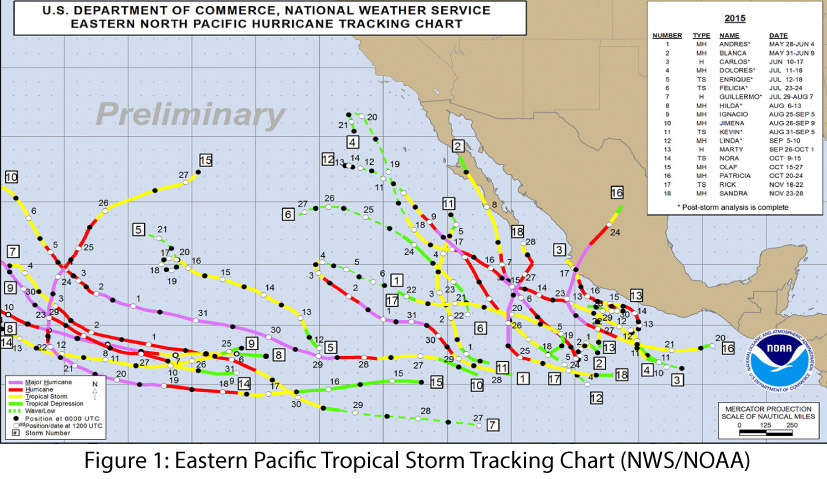2015 - Eastern Pacific Tropical Storm Recap
The 2015 eastern Pacific tropical storm season was one of the most active seasons on record, with 18 named storms and 13 hurricanes, nine of which reached “major” hurricane status (category 3 or greater). We also saw the strongest hurricane on record, Patricia, in the eastern Pacific in late October, and the latest-forming major hurricane on record, Sandra, in late November (see NOAA’s National Hurricane Center for more details). This meets or exceeds the high end of the NOAA-Climate Prediction Center (CPC) seasonal forecast (from May 27), which predicted 15 to 22 named storms, seven to 12 hurricanes, and five to eight major hurricanes. The eastern Pacific hurricane forecast was tied to the ongoing El Niño forecast discussion, as conditions linked to El Niño (e.g., decreased wind shear in the tropical Pacific) also favored increased hurricane frequency and intensity in the Pacific region. Conversely, the Atlantic hurricane season was relatively quiet, with 11 named storms, four of which became hurricanes, including two major ones. This was mostly in line with NOAA-CPC projections of six to 10 named storms, one to four hurricanes, and up to one major hurricane.
The season started off early and strong with two major hurricanes, Andres and Blanca, forming before June 1—Blanca brought considerable moisture into the Southwest—and Hurricane Carlos forming in early June. This start ran counter to the expected early season pattern in which hurricanes remain in the Pacific Ocean and generally head west. Few storms made direct landfall as hurricanes, but numerous systems made their presence felt by driving significant moisture into the Southwest, making substantial contributions to monthly seasonal precipitation totals. The season also was characterized by some relatively anomalous events, in particular, the record-breaking Patricia, which formed very quickly off the coast of Mexico before charging ashore in late October, and the late-forming Sandra. It remains difficult to provide direct attribution of El Niño as the primary cause of specific tropical storm events, but this elevated tropical storm activity and intensity are exactly the sort of patterns that we expect, given the influence that El Niño conditions were forecast to have on the eastern Pacific tropical storm season.


